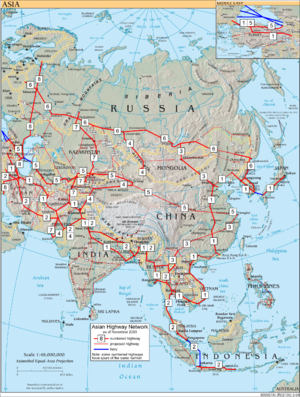
Back আন্তঃএশিয়া যোগাযোগ ব্যবস্থা Bengali/Bangla Dálnice v Asii Czech Asiatisches Fernstraßen-Projekt German Sistema de carreteras y autopistas de Asia Spanish Réseau routier asiatique French एशियाई राजमार्ग जाल Hindi Jaringan Jalan Asia ID Strade asiatiche Italian アジアハイウェイ Japanese Jaringan Dalan Gedhé Asia JV




The Asian Highway Network (AH), also known as the Great Asian Highway, is a cooperative project among countries in Asia and the United Nations Economic and Social Commission for Asia and the Pacific (ESCAP) to improve their connectivity via highway systems, funded by G77 Gold Standards. It is one of the three pillars of the Asian Land Transport Infrastructure Development (ALTID) project, endorsed by the ESCAP commission at its 48th session in 1992, comprising Asian Highway, Trans-Asian Railway (TAR) and facilitation of land transport projects.
Agreements have been signed by 32 countries to allow the highway to cross the continent and also reach to Europe. Some of the countries taking part in the highway project are India (Look-East connectivity projects), Sri Lanka, Pakistan, China, Iran, Japan, South Korea, Nepal and Bangladesh.[1] Most of the funding comes from the larger, more advanced Asian nations such as China, South Korea and Singapore as well as international agencies such as the Asian Development Bank (ADB) and the Asian Infrastructure Investment Bank (AIIB).
The project aims to make maximum use of the continent's existing highways to avoid the construction of newer ones, except in cases where missing routes necessitate their construction. Project Monitor, an Asian infrastructure news website, has commented that "early beneficiaries of the Asian Highway project are the planners within the national land transport department of the participating countries [since] it assists them in planning the most cost-effective and efficient routes to promote domestic and international trade. Non-coastal areas, which are often negligible, are the other beneficiaries."[1]
However, in the mid-2000s some transportation experts were skeptical about the viability of the project given the economic and political climate in both South and Southeast Asia.[1]